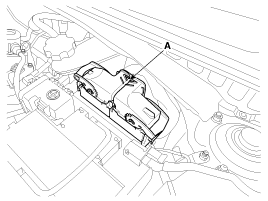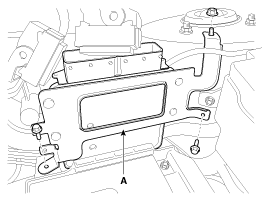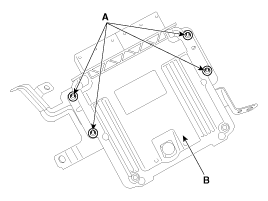 Hyundai Veloster: Engine Control Module (ECM). Repair procedures
Hyundai Veloster 2011-2017 Service Manual / Fuel System / Engine Control System / Engine Control Module (ECM). Repair procedures
Hyundai Veloster: Engine Control Module (ECM). Repair procedures
Hyundai Veloster 2011-2017 Service Manual / Fuel System / Engine Control System / Engine Control Module (ECM). Repair procedures
Hyundai Veloster 2011-2017 Service Manual / Fuel System / Engine Control System / Engine Control Module (ECM). Repair procedures
Removal
When replacing the ECM, the vehicle equipped with immobilizer
must be performed the procedure as below.
[In the case of installing used ECM]
Then the ECM key register process is completed automatically.
[In the case of installing new ECM]
Then the ECM key register process is completed automatically.
|
| 1. |
Turn ignition switch OFF and disconnect the negative (-) battery
cable.
|
| 2. |
Disconnect the ECM Connector (A).
|
| 3. |
Remove the battery (Refer to "Charging System" in EM group).
|
| 4. |
Remove the mounting bolts and nut, and then remove the ECM bracket
assembly (A).
|
| 5. |
Remove the ECM (B) after removing 4 nuts (A) from the bracket.
|
Installation
When replacing the ECM, the vehicle equipped with immobilizer
must be performed the procedure as below.
[In the case of installing used ECM]
Then the ECM key register process is completed automatically.
[In the case of installing new ECM]
Then the ECM key register process is completed automatically.
|
| 1. |
Installation is reverse of removal.
|
ECM Problem Inspection Procedure
| 1. |
TEST ECM GROUND CIRCUIT: Measure resistance between ECM and chassis
ground using the backside of ECM harness connector as ECM side check
point. If the problem is found, repair it.
|
| 2. |
TEST ECM CONNECTOR: Disconnect the ECM connector and visually
check the ground terminals on ECM side and harness side for bent pins
or poor contact pressure. If the problem is found, repair it.
|
| 3. |
If problem is not found in Step 1 and 2, the ECM could be faulty.
If so, make sure there were no DTC's before swapping the ECM with a
new one, and then check the vehicle again. If DTC's were found, examine
this first before swapping ECM.
|
| 4. |
RE-TEST THE ORIGINAL ECM: Install the original ECM (may be broken)
into a known-good vehicle and check the vehicle. If the problem occurs
again, replace the original ECM with a new one. If problem does not
occur, this is intermittent problem (Refer to “Intermittent Problem
Inspection Procedure” in Basic Inspection Procedure).
|
 Engine Control Module (ECM). Schematic Diagrams
Engine Control Module (ECM). Schematic Diagrams
Harness Connector
ECM Terminal Function
Connector [EGGM-A]
Pin No.
Description
Connected to
1
Injector (Cylinder #3) ...
 ETC (Electronic Throttle Control) System. Description and Operation
ETC (Electronic Throttle Control) System. Description and Operation
Description
The Electronic Throttle Control (ETC) System consists of a throttle body
with an integrated control motor and throttle position sensor (TPS). Instead
of the traditional throttle ...
See also:
Front Impact Sensor (FIS). Components and Components Location
Components
...
Components and Components Location
Components
1. TPMS Receiver
2. TPMS Sensor (FL)
3. TPMS Sensor (RL)
4. TPMS Sensor (RR)
5. TPMS Sensor (FR)
...
Overhead Console Lamp. Repair procedures
Inspection
1.
Remove the overhead console lamp (map lamp) assembly then check
for continuity between terminals. If the continuity is not as specified,
replace the map ...
Categories
- Hyundai Veloster Manuals Home
- Hyundai Veloster 2010-2017 Owner's Manual
- Hyundai Veloster 2010-2017 Service Manual
© 2011-2026 Copyright www.hvmanual.com



